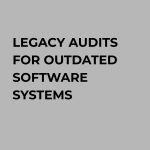Introduction
In today’s rapidly evolving digital landscape, legacy software systems can pose significant business challenges. The risks of relying on legacy application systems are outdated technologies, limited documentation, and security vulnerabilities. A comprehensive legacy software audit is essential for identifying these issues and developing a strategy for modernization.
Understanding Legacy Software Systems
Legacy application systems are characterized by age, often using outdated hardware and software. They may lack proper documentation, making them difficult to maintain and update. These systems can be vulnerable to security threats, and their continued use can hinder a company’s ability to innovate and adapt to changing market conditions.

Key Considerations for Legacy Software Audits
When conducting a legacy application audit, it’s essential to consider the following factors:
- Scope Definition: Clearly define the audit scope to focus on specific systems, processes, or data.
- Resource Allocation: Allocate sufficient resources, including personnel, time, and budget, to ensure a thorough audit.
- Stakeholder Involvement: Engage key stakeholders throughout the audit to gather valuable insights and ensure buy-in for recommendations.
- Data Collection and Analysis: Develop a plan for collecting and analyzing relevant data, including system logs, documentation, and stakeholder interviews.
- Risk Assessment: Identify and assess potential risks associated with legacy software systems, such as security vulnerabilities, data quality issues, and operational inefficiencies.
- Clearly Define Your Goals and Objectives: Determine what you hope to achieve through the audit, such as identifying risks, improving efficiency, or reducing costs. Ensure that the audit aligns with your overall business goals and objectives.
- Choose the Right Audit Firm: Select an audit firm with a proven track record in conducting legacy audits and a deep understanding of your industry. Ask for references and testimonials from previous clients to assess the firm’s capabilities.
- Provide Adequate Access and Support: Ensure that the audit firm has access to all necessary data and systems. Provide access to relevant subject matter experts who can assist the audit team.
- Collaborate Throughout the Audit Process: Be actively involved in the audit process to provide valuable insights and ensure that the audit meets your needs. Maintain open communication with the audit team to address any questions or concerns.
- Leverage the Audit Findings: Ensure that the audit report includes clear and actionable recommendations. Develop a plan for implementing the recommended changes and continuously monitor the effectiveness of these changes.
By following these best practices, organizations can conduct effective legacy software audits and make informed decisions about the future of their outdated systems.
Conclusion
In today’s rapidly evolving digital landscape, legacy systems can pose significant risks and hinder business growth. By conducting a comprehensive legacy audit, organizations can identify potential vulnerabilities, inefficiencies, and opportunities for modernization.
By following the best practices outlined in this guide, you can ensure that your legacy audit is effective and efficient and provides valuable insights for making informed decisions about the future of your systems.Don’t let outdated legacy systems hinder your business growth. Contact us today to schedule a legacy software audit.



